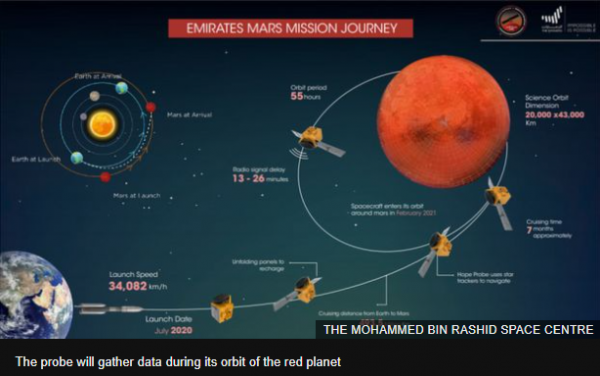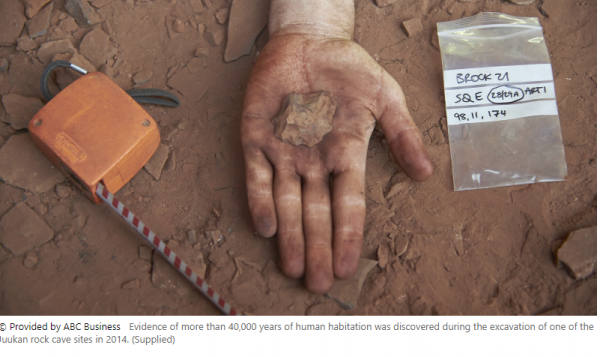-
Posts
20,851 -
Joined
-
Last visited
-
Days Won
49
Everything posted by CaaC (John)
-
UAE Mars mission: Hope project a 'real step forward for exploration' The first Arab space mission to Mars is preparing to lift off within weeks. Fuelling is due to begin next week. It will take seven months to travel the 493 million km (308 million miles) to reach Mars and begin its orbit, sending back ground-breaking new data about its climate and atmosphere. The probe will remain orbiting Mars for an entire Martian year, 687 days, to gather sufficient data. A single orbit around Mars will take the probe 55 hours. In a briefing on Monday, programme director Sarah Al-Amiri said the project should be a major incentive for young Arab scientists to embark on a career in space engineering. The United Arab Emirates reaches for the Red Planet Named Amal, meaning Hope, the robotic craft is due to lift off from a remote Japanese island, Tanegashima, during a narrow launch window on 14 July. Powered by a Japanese rocket, it will be carrying three types of sensors for measuring the complex make-up of Mars's atmosphere. These include a high-resolution multiband camera for measuring the planet's dust and ozone. The second will be an infrared spectrometer for measuring both the upper and lower atmosphere and developed by Arizona State University, one of the project's three US partner universities. The third sensor will be an ultraviolet spectrometer for measuring oxygen and hydrogen levels. Ms Al-Amiri said one of the focuses of the research will be into how these two elements, essential for water, are escaping from the planet. Sir Ian Blatchford, director of the UK's Science Museum Group, pointed out that "a lot of missions have focused on geology, but this will provide the most comprehensive, holistic picture of Mars's climate". The UAE has a track record of space travel. It has sent rockets into the Earth's orbit and one of its astronauts to the International Space Station. Hazzaa Al Mansoori to become first Emirati astronaut The first Arab astronaut to go into space was Saudi Arabia's Prince Sultan Bin Salman Al-Saud, who flew on the US space shuttle in 1985. But this is of a totally different magnitude. The spacecraft was built in the UAE and shipped to Japan, where all its engineers immediately had to go into quarantine due to the coronavirus pandemic, threatening to delay the launch. Monica Grady, professor of planetary and space science at Britain's Open University, believes this Mars mission marks a major change in an industry previously dominated by the major powers of the world. "It's a real step forwards for Mars exploration because it shows that other nations - rather than the European Space Agency and Nasa can actually go there - well we hope it will get there. Mars has a very long history of mission failures," she said. UAE project leaders working on the mission have reminded the world that, eight centuries ago, Arab inventors and intellectuals were right at the forefront of scientific discovery. So today, the ruler of Dubai, one of the seven emirates that make up the UAE, is hoping this ambitious project will rekindle a sense of cultural pride and help the region to diversify away from its dependence on the oil industry. Provided it does reach Mars, Hope will arrive at the red planet in the same year that the UAE celebrates 50 years since its founding as a nation in 1971. Certainly, no one could accuse the country of lacking in ambition. It has vowed to build a human settlement on Mars by the year 2117. https://www.bbc.co.uk/news/world-middle-east-52973849
-
That is a bit like this... The Red Summer of 1919 and how race riots broke out during a global flu pandemic
-
This May Have Been Earth's First-Ever Land Animal The first creepy crawlies to climb out of Earth's ancient lakes and make their way on land may very well have done so with hundreds of tiny feet. After carefully dating the earliest bug fossils ever discovered, scientists now think an extinct genus of myriapod, a relative of modern millipedes, represents the earliest direct evidence of an animal living and breathing on land. Life on Earth started in a primordial soup, and bugs - or more specifically arthropods, including insects, spiders and centipedes - are thought to be some of the first animals to leave this comforting bath for good. In fact, other types of insects are suspected to have beat myriapods to land. But we only have indirect evidence of their soil-based forays through tracks and trails, and these may only represent fleeting excursions to the world above, rather than making it their permanent home, like myriapods did. Discovered for the first time in 1899 on a Scottish isle, the fossil of the myriapod Kampecaris obanensis has now been radiometrically dated to roughly 425 million years ago. If the new date is correct, these ancient many-legged ones would be the oldest land animals to have lived out of water. And their journey was pioneering. Just 20 million years after Kampecaris, the fossil record reveals bountiful bug deposits, and 20 million years after that, spiders and insects appear to be thriving in forest communities. "It's a big jump from these tiny guys to very complex forest communities, and in the scheme of things, it didn't take that long," says geoscientist Michael Brookfield from the University of Texas, and the University of Massachusetts in Boston. "It seems to be a rapid radiation of evolution from these mountain valleys, down to the lowlands, and then worldwide after that." This is, of course, only based on the fossils we have found so far, but researchers say the fact that there are no other discoveries out there, despite looking at some of the best-preserved sediments from this era, could indicate the end of the road. If the team is right, and this ancient species was indeed the first of all water-to-land pioneers that we know of, then it looks like we've been seriously underestimating how quickly this transition occurred. According to a technique called molecular clock dating, which is based on the mutation rate of DNA, fossils of stemmed plants in Scotland have also turned out to be roughly 75 million years younger than we once thought, coinciding with the Kampecaris timeline. Not only were bugs in Scotland adapting to life on land at a rapid pace; this finding implies forests were doing so at much the same rate, and it's very likely the two are somehow connected. Given how important these bugs are thought to be in our planet's history, Brookfield was surprised to find this fossil hadn't been dated before, although he admits it is time-consuming and delicate work. When analysing these ancient rocks, scientists must extract microscopic inclusions of zircon, which can be used to accurately date sediment. This practice requires an eagle eye and a careful hand, and given how quickly these zircons can be accidentally flushed away, there's not a lot of room for error. Geoscientist and co-author Stephanie Suarez has been mastering this technique since her undergraduate years, and she's used it in the past to prove a different millipede specimen (Pneumodesmus newman) was not the oldest bug on land but was actually 14 million years younger than we thought. After years of careful work, she now gets to crown a new victor. Who knows if we'll get to dethrone it one day, too. https://www.msn.com/en-gb/news/offbeat/this-may-have-been-earths-first-ever-land-animal/ar-BB15anFF
-
Astronomy Picture of the Day 2020 June 7 Halo of the Cat's Eye Image Credit & Copyright: R. Corradi (Isaac Newton Group), Nordic Optical Telescope Explanation: The Cat's Eye Nebula (NGC 6543) is one of the best known planetary nebulae in the sky. Its haunting symmetries are seen in the very central region of this stunning false-colour picture, processed to reveal the enormous but extremely faint halo of gaseous material, over three light-years across, which surrounds the brighter, familiar planetary nebula. Made with data from the Nordic Optical Telescope in the Canary Islands, the composite picture shows extended emission from the nebula. Planetary nebulae have long been appreciated as a final phase in the life of a Sun-like star. Only much more recently, however, have some planetaries been found to have halos like this one, likely formed of material shrugged off during earlier active episodes in the star's evolution. While the planetary nebula phase is thought to last for around 10,000 years, astronomers estimate the age of the outer filamentary portions of this halo to be 50,000 to 90,000 years. NASA
- 1,657 replies
-
- space exploration
- astronomy
-
(and 1 more)
Tagged with:
-
Thomas Edison’s First Patented Invention—a Voting Machine for Congress—Was a Total Flop On June 1, 1869, Thomas Edison patented his very first invention: a voting machine meant for Congress. According to Rutgers University’s Thomas A. Edison Papers Project, the 22-year-old inventor might’ve been inspired to design the device after newspaper reports announced that both the New York state legislature and the city council of Washington, D.C., were investigating means of automating their ballot process. At the time, legislators voted by calling out “Yea” or “Nay” (or something of that nature), and a clerk jotted down their responses one by one. Edison’s “electrographic vote-recorder” had the names of all the voters listed twice: in a “Yes” column on one side, and a “No” column on the other. When a person flipped a switch to indicate their vote, the machine would transmit the signal through an electric current and mark their name in the corresponding column, while keeping track of the total tally of votes on a dial. After everyone had voted, an attendant would place a sheet of chemically treated paper on top of the columns and press down on it with a metallic roller, imprinting the paper with the results. Thomas Edison electrographic vote-recorder patent 1869 A telegraph operator named Dewitt Roberts invested $100—about $1754 in today's dollars, according to Tech Times—in the device and set off for an exhibition on Capitol Hill. Alas, members of Congress were completely uninterested, and the committee chairman in charge of deciding its fate declared that “if there is any invention on earth that we don't want down here, that is it.” The committee didn’t think the vote-recorder streamlined the process enough to be useful, but it’s possible they weren’t too keen on speeding things up in the first place. If the officials didn’t voice their votes aloud, there wouldn’t be any opportunity to filibuster policies or persuade each other to switch their stances—an integral part of congressional proceedings. Edison, of course, recovered from his first flop. He went on to invent (or at least improve upon) the light bulb, create the cat video, and devise many more notable creations. https://www.msn.com/en-gb/news/offbeat/thomas-edisons-first-patented-invention—a-voting-machine-for-congress—was-a-total-flop/ar-BB158SEo
-
These animals build palaces out of their own snot A close-up view of the giant larvacean, the blue tad-pole-like swoosh in the centre, and its snot palace. Every animal has its own idea of the perfect home. For the giant larvacean, that home is pretty darn weird—and new research shows that their slimy homes are even wackier than we thought. With their bulbous heads and flat tails, these gelatinous invertebrates look like big, ghostly tadpoles. Though they grow to reach the size of a breakfast muffin, they are usually surrounded by self-constructed “snot palaces” as big as 1 meter in length. Now, new insight published Wednesday in Nature shows new structural details hidden in all the goop. Scientists mounted laser technology to remotely-operated submersible vehicles, launching them into the ocean 400 meters down to scan those delicate homes. By digitally reconstructing what they observed, the scientists found giant larvacean snot palaces have two nested structures: an inner house and an outer house. “One way to think about it is like the brain and then the skull surrounding the brain,” says Kakani Katija, a principal engineer at the Monterey Bay Aquarium Research Institute (MBARI) who led the research. The outer house protects them from predators—making them harder to spot while providing a squishy, protective barrier—but also as a primary water filter, she says. It surrounds the inner house, which collects all the food away from the water, and they are separated by a small inlet channel. Katija says the whole thing is an elaborate feeding apparatus. Here's a close-up view of a "giant larvacean" (blue tadpole-like animal) and its "inner house." What’s particularly awe-inducing is how these larvaceans construct such intricate structures. Before they build their homes, larvaceans have cells lining their heads that only exist to secrete mucus. Then, all in one go, they release that mucus and inflate it like “a bouncy castle,” Katija says. “Think of a balloon that hasn't been blown up,” she continues. The whole mucus house is secreted at once, flat and formless, and then blown up in less than an hour to be fully inflated and operational. “It's pretty incredible to watch,” she says, especially since larvaceans have no appendages to work with. “A spider has eight legs to build and lay down material for its web. This animal really just has a head and a tail.” As intricate as these jelly castles are, they aren’t built to last. Within just one or two days, the filters eventually clog and the larvaceans abandon ship, promptly setting off to make a new palace. The discarded house, stuffed-up with nutrients sinks down to the ocean floor, where it nourishes the ocean’s bottom-feeders. While larvacean mucus houses have been observed as early as the 1960s, scientists have had a hard time getting a critical look. These gelatinous structures are so delicate that you can’t capture them and drag them up to the surface the same way you would with other creatures. The only way to get an accurate look at these animals is to watch them where they live—a logistical and technological challenge. MBARI overcame this barrier with the DeepPIV, a scanning instrument that uses laser technology developed by Katija and her team. DeepPIV emits a laser “sheet”—gelatinous material lights up when hit by the laser, allowing the scientists to note how the larvacean and its house are positioned. Every time the instrument was repositioned, the team saw a new two-dimensional “slice” of a larvacean house. By scanning the laser back and forth and compiling each slice of information, the team was able to non-invasively visualize the animals while digitally reconstructing a three-dimensional model. How exactly these strange ocean animals manage to build their mucus houses in their small, simple bodies is still a mystery, but Katija knows there is a lot to learn. “Larvaceans can filter a wide range of particle sizes… and they can do this at very high efficiency, like 95-99%. How well do our own engineering systems do in that regard?” Katija says. “Is there some feature or some mechanism that these mucus structures are using?” Katija hopes that as they continue their discoveries, these structures will inspire future filtration technology or medical applications. There are so many captivating animals from the ocean’s midwaters that are understudied, she says. Now that there’s a way for them to reconstruct their body shapes, it opens up so many more opportunities for understanding them. ”That’s really what we’re hoping for when we illuminate something novel in the deep sea.” https://www.msn.com/en-gb/news/offbeat/these-animals-build-palaces-out-of-their-own-snot/ar-BB158QrO
-
I wonder for how long this time?
-
@Stan, @Dan, your thoughts on the guy, please.
-
Coronavirus: This is not the last pandemic We have created "a perfect storm" for diseases from wildlife to spill over into humans and spread quickly around the world, scientists warn. Human encroachment on the natural world speeds up that process. This outlook comes from global health experts who study how and where new diseases emerge. As part of that effort, they have now developed a pattern-recognition system to predict which wildlife diseases pose the most risk to humans. This approach is led by scientists at the University of Liverpool, UK, but it is part of a global effort to develop ways to prepare better for future outbreaks. Exploiting nature 'drives the outbreaks of new diseases' Coronavirus: A hunt for the 'missing link' species With a million species at risk, what do we save? FULL REPORT
-
True TV anchor says ejaculate instead of eject
-
North Atlantic gannet found on Norfolk trampoline A seabird native to the North Atlantic has been rescued by the RSPCA after it took up residence in a Norfolk garden. Dawn Austin discovered the gannet resting on a trampoline in her North Wootton garden on Tuesday and contacted vets when it did not fly away. The animal welfare charity suspects the bird "was blown off course". A spokeswoman for the RSPCA said there were no "obvious injuries" but the gannet was "very weak" and vets were doing all they could to help him. Gannets are a protected species under the Wildlife and Countryside Act 1981 and can dive at speeds of 60mph (96.5kmh) to catch fish. Ms Austin said: "I had gone to let my dog out in the morning and when I looked out in the garden I saw this huge bird sitting on the trampoline just staring at me. "The bird didn't look injured or distressed so I presumed it would just fly off. But when I came home he was still there - but this time sitting in the sunshine at the bottom of the garden." After managing to safely catch the bird with a towel, Ms Austin took the gannet to the RSPCA East Winch wildlife centre. While the RSPCA were grateful for Ms Austin's help they have advised people not to try and catch large wild birds themselves. Centre manager Alison Charles said: "As with lots of wildlife we never know why they sometimes get into difficulty and end up needing our help. "We suspect that he was blown off course - but we do not know why." Ms Charles said staff at the centre were feeding him three times a day as he was unable to feed himself, but they hoped that "having a chance to rest and recover" would help him "find the strength to pull through". https://www.bbc.co.uk/news/uk-england-norfolk-52938253
-
-
A report reveals Rio Tinto knew the significance of 46,000-year-old rock caves six years before it blasted them Mining giant Rio Tinto was alerted six years ago that at least one of the caves it blasted in Western Australia's Pilbara region last month was of "the highest archaeological significance in Australia". The cave sites were among the oldest in Australia, with evidence of continuous human habitation going back 46,000 years. The advice delivered to Rio Tinto and the Puutu Kunti Kurrama and Pinikura (PKKP) Indigenous people of the region six years ago was never publicly released. The ABC has been given a summary of the contents of the report, as well as earlier archaeological survey work and excavations at the sites dating back to 2004. The documentation of the 2014 report by archaeologist Dr Michael Slack confirmed one of the sites that were blasted, the Juukan-2 (Brock-21) cave, was rare in Australia and unique in the Pilbara. "The site was found to contain a cultural sequence spanning over 40,000 years, with a high frequency of flaked stone artefacts, a rare abundance of faunal remains, unique stone tools, preserved human hair and with sediment containing a pollen record charting thousands of years of environmental changes," Dr Slack wrote. "In many of these respects, the site is the only one in the Pilbara to contain such aspects of material culture and provide a likely strong connection through DNA analysis to the contemporary traditional owners of such old Pleistocene antiquity." FULL REPORT
-
Massive 3,000-year-old ceremonial complex discovered in 'plain sight' SLIDES- 1/3 (Video by GeoBets) An enormous 3,000-year-old earthen platform topped with a series of structures, including a 13-foot-high pyramid, has been identified as the oldest and largest monumental construction discovered in the Maya region, according to a paper published today in the journal Nature. It’s the latest discovery to support the emerging view that some of the earliest structures built in the Maya region were significantly larger than those built more than a millennium later during the Classic Maya period (250-900 A.D.) when the empire was at its peak. The discovery took place in Mexico’s Tabasco state at the site of Aguada Fénix, about 850 miles east of Mexico City. It is in a region known as the Maya lowlands, from which the Maya civilization began to emerge. In 2017, researchers conducted a LiDAR survey that detected the platform and at least nine causeways leading up to it. The groundbreaking laser technology typically is used from aircraft to “see” structures beneath dense tree canopy below, but in this case, it revealed a stunning discovery sitting unnoticed in plain sight in Tabasco’s semi-forested ranch lands for centuries, if not millennia. So why was such a big monument at Aguada Fénix not identified earlier? “It’s fairly hard to explain, but when you walk on the site, you don’t quite realize the enormity of the structure,” says archaeologist Takeshi Inomata of the University of Arizona, the lead author of the paper. “It’s over 30 feet high, but the horizontal dimensions are so large that you don’t realize the height.” “Rituals we can only imagine” The initial construction of the platform is believed to have begun around 1,000 B.C. based on radiocarbon dating of charcoal inside the complex. But the absence of any known earlier buildings at Aguada Fénix suggests that at least up until that period, the people living in the region—likely the precursors of the Classic Maya—moved between temporary camps to hunt and gather food. That has researchers speculating over how and why they suddenly decided to build such a massive, permanent structure. Inomata estimates that the total volume of the platform and the buildings on top is at least 130 million cubic feet, meaning it is bigger even than the largest Egyptian pyramid. He also calculated that it would have taken 5,000 people more than six years of full-time work to build. “We think this was a ceremonial centre,” Inomata says. “[It’s] a place of gathering, possibly involving processions and other rituals we can only imagine.” No residential buildings have been found on or around the structure, so it is unclear how many people may have lived nearby. But the large size of the platform leads Inomata to think that the builders of Aguada Fénix gradually were leaving their hunter-gatherer lifestyle behind, likely aided by the cultivation of corn—evidence of which also has been found at the site. “The sheer size is astonishing,” says Jon Lohse, an archaeologist with Terracon Consultants Inc. who studies the early history of the area and was not involved in the report. He does not think, however, that the structure itself is evidence of a settled lifestyle. “Monumental constructions by pre-sedentary people are not uncommon globally.” What it does unmistakably show, Lohse adds, is an advanced ability for people to collaborate, probably in the strongly egalitarian fashion that he believes was typical of early societies in the Maya region. Inomata agrees and thinks the platform was built by a community without a strong social hierarchy. As potential evidence, Inomata points to the even older ceremonial site of San Lorenzo, 240 miles to the west in a region that was settled at the time by the Olmec people. Built at least 400 years earlier than Aguada Fénix, San Lorenzo features an artificial terraced hill that may have had a similar function. But it also has colossal human statues that may indicate that some people held a higher status in society than others. It may seem likely that the people who built Aguada Fénix were inspired by San Lorenzo, but archaeologist Ann Cyphers of the Universidad Nacional Autónoma de México, who has worked at San Lorenzo, considers the sites “quite distinct,” adding that the pottery found it is also very different from that found at Aguada Fénix. A checkerboard of coloured soil So what might have been the purpose for undertaking such a massive communal building project? Study coauthor Verónica Vázquez López of the University of Calgary believes that it might have been a statement of intent: a formal collaboration designed to bring different groups of people together over the course of several generations. Some features at Aguada Fénix could suggest this collaboration, such as a cache of precious jade axes that may have symbolized the end of the collaborative construction project. Archaeologists also have noted that some of the layers of soil used to build the platform were laid down in a checkerboard pattern of different soil colours, which may have symbolized the contribution of different groups. “Even today, people who live in different quarters of some Mexican towns each clean their part of the central church plaza,” Vázquez López observes. By 750 B.C., the monumental structure at Aguada Fénix was abandoned, and by the Classic Maya period more than 1,000 years later, people in the region were building higher pyramids that became accessible only to the elite atop much smaller platforms with less space for broader communities to gather. “In the early period, people got very excited,” Inomata says. “Later on, they became a bit less enthusiastic.” https://www.msn.com/en-gb/news/offbeat/massive-3000-year-old-ceremonial-complex-discovered-in-plain-sight/ar-BB150mSY
-
Just watched the trailer and it looks alright and the good thing is I can watch the full movie on our Youtube channel, I can't see it on our Netflix channel.
-
@Bluewolf, if you liked The Ballad of Buster Scruggs' then you just might like this one too, unless you have already seen it, I would give it an 8.0/10 and I have watched it a few times.
-
As per above, Evalyn passed away last night, gutted, so is the wife and because of the lockdown we could not go and visit her in the hospital and now we can't even go to her funeral, life can be a bastard sometimes. Edit, 17th June: Just found out from Evalyn's hubby that we can go to her funeral, it's only family and a few friends that can attend as by the coronavirus rules on funerals so we can say a proper good by, God bless her, leaving here shortly for the funeral.
-
Just for you @nudge, the saloon scene.
-
I quite enjoyed it and watched it a couple of times.
-
Scotland: The trailblazers behind women's national game The summer of 2019 will be remembered as the moment Scottish women's football achieved global recognition. Shelley Kerr's Scotland squad qualified for their first World Cup, two years after their first major tournament appearance at the European Championship. Last summer's finals in France ultimately ended in heartache as a gut-wrenching draw with Argentina denied them a place in the knockout stages but, nevertheless, it was seen as the pinnacle of the national team's achievements to be mixing it with the world's best. However, there are many whose dedication, perseverance and talent laid the foundations. Women whose sacrifices for years had gone largely unrecognised and appreciated in the shadow of the men's game. In the latest instalment of our National Treasures series, BBC Scotland looks at five players whose contribution changed the face of women's football north of the border. FULL REPORT
-
Never tried that one but I remember before Guy Fawkes day making a guy and wheel it around shouting "Penny for the guy", get the dosh then bloody burn him on a bonfire
-
Yep, we made them out of old pram wheels etc and go up the local hill called Chadwell Hill and belt down it having races.
-
Nah, the footy, wake up on a cold frosty morning with a football that had the bladder hanging out and meet your pals in the street or field, sling coats or jumpers down for goalposts and kick away, we had no football boots then just either bare feet or shoes with holes in them. Get soaked to the skin and arrived home with cuts on your knees, black eyes where a football soaked in water and heavy as fuck hitting your face or lumps on your head from heading the ball, covered in mud and your mother screaming at you to strip off and get in the bath and your dad looking at you with a big smile on his face, those were the days.
-
OLd thread about the good old days.











.thumb.png.51c5ebae20450841abf3589533258442.png)
.thumb.png.8990a1b71bd9c1c6f5dcd9fe3fd80979.png)








